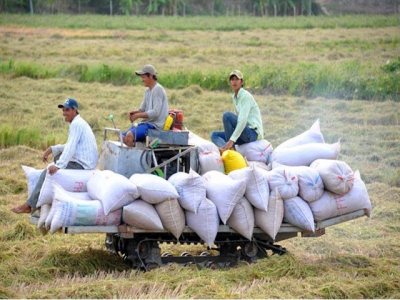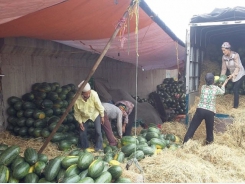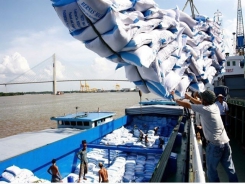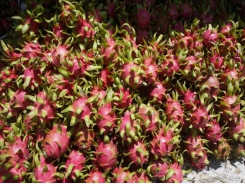Joy for all, except farmers

Vietnam’s exports in 2019 are an impressive result, especially amid the negative export growth of many big economies. Every Vietnamese is pleased with this result, except farmers.
In contrast to the overall bright picture, the agriculture sector last year performed quite poorly, with exports down 4.5% year-on-year - PHOTO: LE HOANG VU
Vietnam’s exports in 2019 reached US$263.4 billion, up 8.1% from the year earlier, and the country enjoyed a trade surplus of US$9.9 billion, the fourth consecutive year with trade surplus. This is a success beyond expectation. However, not all sectors enjoy this success.
In contrast to the overall bright picture, the agriculture sector last year performed quite poorly, with exports down 4.5% year-on-year. This is the first setback after years of consecutive export growth, and up to seven out of nine agro-commodities suffered an export drop. Agro-product exports (*) slowed down while the agriculture sector was thought to have made a big stride forward, with outstanding performance in some fields and areas.
Downtrend continues
Fisheries exports last year generated nearly US$8.6 billion, down 2.4% from 2018. One of the hurdles for the fisheries sector is the EU’s yellow card for illegal, unregulated and unreported (IUU) fishing. The EU issued the card in October 2017 and extended its validity to April 2018 and then to January 2019. In November 2019, a delegation from the European Commission came to Vietnam for inspection and requested the country to continue improvement, which means that the yellow card will be in place at least until June 2020.
During the time under the yellow card, all fisheries export shipments may be subject to inspection for the origin of exploitation. The time of inspection is around three to four weeks per container, and the inspection fee is some 500 pounds per container, not to mention the warehousing fee and other implications. There are cases, such as the Philippines, where up to 70% of the fisheries shipments are denied customs clearance.
Last year, tra (pangasius) fish exports dipped 10% from 2018. Shrimp processing factories had to use up to 40% of imported materials, as the problem of antibiotic residue in local shrimps was not yet solved.
In 2017, the target for vegetable and fruit exports for 2018 was set at US$4 billion, but actual exports reached only US$3.8 billion. The US$4-billion target was even farther in 2019 when actual exports were only US$3.76 billion, down 1.1% year-on-year. The 1.1% drop seems insignificant, but it has a big impact on farmers. The export drop involved not only staple fruits but also spices like chili and mushrooms. Shipments of southern fruits like dragon fruit and watermelons must wait long for customs clearance at border gates with China. In previous years, Chinese traders used to buy pineapples on the field in Lao Cai Province, but the fruit faced a slump in sales in 2019 when the border trade was tightly controlled.
While vegetable and fruit exports faced a tough time, imports of these products in 2019 were “favorable” with a turnover of US$1.7 billion, equivalent to 45% of the export turnover. Worse, foreign vegetables and fruits found their ways into Vietnam easily. They included not only fruits from America, Europe and Australia but also fruits available in Vietnam, such as durians, rambutans, oranges, tangerines and mangosteens.
Though Vietnam remains the world’s top cashew exporter, the country’s exports of cashew nuts in 2018 fell 3.9% from 2017, and in 2019 2.2% from 2018. The reason for the export drop is the discrepancy between the production and the processing capacity of the cashew industry. The domestic raw cashew supply can meet only 30% of the processing capacity; so the industry has to import a large volume of cashews, mainly from Africa. The Ivory Coast alone accounts for 35% of the raw cashew import volume. The African exporters will keep their raw cashews for processing in the coming time, and the Ivory Coast plans to do this from 2020.
Vietnam is the world’s second largest coffee exporter, but her coffee exports in 2019 declined as much as 21.2% from the previous year, the largest drop among agro- and fisheries product exports.
Rice exports were once the proud achievement in the renovation period, but the trade has been facing multiple challenges in recent years, especially in 2019. Major markets like China, Indonesia and Bangladesh have reduced buying Vietnamese rice. Meanwhile, the U.S. Department of Agriculture has forecast that the global rice supply will rise due to an increase in rice production by major agricultural countries.
Black pepper exports have slumped, as the price has been on a downward trend, from US$10 per kilo in 2015 to less than US$2 per kilo in 2019. The global black pepper supply increases 8-10% per year while the world’s annual demand inches up only 2-3%.
Slight increase
Two of nine agro- and fisheries products posted export growth, but it’s not really good news. Vietnam is among the world’s top five tea producers and exporters, but her tea exports have stood at around US$200 million for many years. Though exports in 2019 increased 8.8% from the year earlier, the absolute figure of the additional income is only US$19 million, still insignificant. The other commodity, rubber, achieved strong export growth, at 10%, but it is laden with problems. First, the area of small-holding rubber farms make up as much as 43.2% of the total rubber acreage, with the participation of more than 265,000 farming households. Due to loose cooperation and difficulty in control of technology and cultivation processes, their rubber has unstable quality and the price is often VND1-1.5 million lower than that of rubber from big rubber farms. Second, the rate of old rubber trees in traditional rubber growing areas is high, so the rubber production and quality are declining. Third, 80% of natural rubber is exported under the raw processed form.
Shrinking market
Vietnam’s agro- and fisheries exports depend heavily on the Chinese market. China makes up 73% of vegetable and fruit exports and 65% of rubber exports. China has been the leading market for cassava and cassava products over the past many years. The country ranks second among seven major markets for Vietnam’s cashew nuts. It is the top among the nine buyers of Vietnamese rice and also the top among the eight largest importers of Vietnam’s tra fish.
It would be satisfactory if Vietnam had a stable and big neighboring buyer of her agro- and fisheries products. However, it implies more harm than good to trade with this “capricious” buyer, which constantly poses risks.
Fresh opportunities hard to grasp
New generation free trade agreements (FTAs) have eliminated tariffs for Vietnam’s agro- and fisheries product exports. However, it’s not easy for Vietnamese products to penetrate immediately into the markets of FTA partners. Technical barriers, which make it difficult to enter these markets, cannot be easily overcome overnight. Meanwhile, agro-products of FTA partners can take advantage of the agreements to enter the local market, and Vietnamese agro-products must struggle to keep a foothold on the home ground.
Though Vietnam’s agriculture has made progress, the sector is still plagued with the shortcomings of a fragmented production system. Farmers are led by mob psychology, ready to break planning and rush for growing a certain crop and later chop it down. Plant protection chemicals are randomly used and the processing technology is obsolete.
These are the reasons for the poor export performance of agro- and fisheries products amid the bright export picture in 2019, in addition to the fall in prices of these commodities in the global market. With such a background, it’s hard for the agriculture sector to enter 2020 with an optimistic mood.
(*) Agro- and fisheries products are the first group in the list of key export commodities. They do not include exports of wood and woodwork which are often added to the revenue of agro-product exports.
Source: Figures from the Table for commodity exports by group in Quarter 1, six months, nine months and 12 months of 2019 by the Import-Export Department under the Ministry of Industry and Trade.
Related news
Tools

Phối trộn thức ăn chăn nuôi

Pha dung dịch thủy canh

Định mức cho tôm ăn

Phối trộn phân bón NPK

Xác định tỷ lệ tôm sống

Chuyển đổi đơn vị phân bón

Xác định công suất sục khí

Chuyển đổi đơn vị tôm

Tính diện tích nhà kính

Tính thể tích ao




 Việt Nam needs to find new rice markets…
Việt Nam needs to find new rice markets…  US Department of Agriculture gears up inspection for…
US Department of Agriculture gears up inspection for…